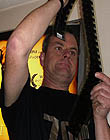|
|
This topic comprises 2 pages: 1 2
|
|
Author
|
Topic: Oops! i guess we dropped the print
|
Andy Muirhead
Master Film Handler

Posts: 323
From: Galashiels, Scotland
Registered: Dec 2000
|
 posted 07-19-2001 08:22 PM
posted 07-19-2001 08:22 PM




Ok folks, your going to love this one!Being a 4 screen with 4 independent proj rooms, we have to move prints about quite a lot, so we had to move Pearl Harbor from 3 to 4 tonight and you all know how big that is. Anyway we have a few different procedures for moving prints, just depends what we think is necessary. So me and my mate are taking it easy with the print, were almost at number 4 when, (insert approriate sound effect here) the 'woody' pops out of print, and we are left standing with 3 hours of film just kind of hanging off our arms. Ok imagine you lift a film off the platter and stand it vertical, yeah?, now pull out the take up ring, with about 3 reels of the feature - yep, thats what happened! Thats not so bad with a short enough film like say a 6 reeler or something, but Pearl Harbour? Comes in at 3 hours +. I'll add that this happened about 10mins before the film was due to start. One thing i should add is that the first 3 reels were saved and presentable, ie we could show the first 3 reels, but the rest of the film was lying in a heap on the foyer floor. Do you think we made it? What would you do?
| IP: Logged
|
|
|
|
|
|
|
|
|
|
Brad Miller
Administrator

Posts: 17775
From: Plano, TX (36.2 miles NW of Rockwall)
Registered: May 99
|
 posted 07-20-2001 03:54 AM
posted 07-20-2001 03:54 AM




There is actually a very good way to pick up the mess of a thrown print. It's difficult to explain, but I picked up 7 reels of a thrown print of Titanic for a local theater and only had to make 5 splices to do it. (The print was about 10 feet from the platter, so it got a real good throw!)The major secrets to salvaging a print that has been dropped are: #1 Separate the reels at the changes first! Do NOT just go cutting here and there or you will end up with one hell of a tangled mess on your hands. Save any large obvious loops of film and get them back onto a reel using the MUT by pulling the film through the brain so the platter can feed the film rather than using the drill and core trick. This keeps the film from getting scratched and cinch marked if you hold the film between your fingers as it winds onto the reel. #2 When you absolutely HAVE to cut the film, find a camera change and cut 2 perforations out of frame. Yes you read that right, find the frameline of a camera cut and cut it with a pair of scissors exactly 2 perforation holes to either side. That INSURES you get the film back together in the proper order, allows you the ease of a pair of scissors amidst the spaghetti (as opposed to a splicer), coupled with the accuracy of a good overlap splice (see "splicing tips" on this site) and the loss of only one frame (which "most" of the time will not be noticeable at a camera cut. The odds are definitely on your side here.) If the film is cut randomly in the middle of a shot, the splice WILL show no matter what. Following this trick will in most circumstances make the splice invisible, especially if the film is playing in digital sound. #3 Once you get the film wound back onto reels and/or cores, make sure that each roll is "heads up". #4 Find the first roll and start loading it back onto the platter (or preferably build this back onto large reels and then rewind and load to the platter via the MUT when you are finished). When you reach the end of that first roll, look at the 2 perfs of the last frame on the roll and match it to what is obviously the matching next roll. Keep doing this until you finish the film. #5 Curse a bit and properly time that platter. Beer is optional. Hogan, how long did that mess take you to pick up? If the film was never taken up by the platter and the projector just kept dumping it onto the floor like you described (in another thread), there is a quick way to get the ENTIRE thing up off of the floor without scratching (or extremely minimal at worst) and all in ONE PIECE. How? Simple. Pull your MUT over to the platter and plug it in. Get your biggest reel you have and put it on the MUT. Now (with the projector stopped, duh) cut the film 2 perfs off of a camera cut as it exits the projector...but DO NOT DROP THE FILM! Take that last foot of film and secure it to the large reel on the MUT. Now set the MUT for break-down and turn it on while you hold your hand up high in the air (the film passing through your fingers). The film will unwind from the top of the pile in exactly the reverse manner of which it piled onto the floor originally. When you are done, load that reel onto the platter and re-join the film where you cut it to the end of the film on the platter and finish the show. I've picked up 4 reels of film before in this manner and it took less than 10 minutes to do. The print didn't have a scratch! (Thankfully it was a carpeted booth.)
| IP: Logged
|
|
|
|
John Pytlak
Film God

Posts: 9987
From: Rochester, NY 14650-1922
Registered: Jan 2000
|
 posted 07-20-2001 05:52 AM
posted 07-20-2001 05:52 AM





I'll say it again: Carrying a full made-up print without proper support is like playing Russian Roulette --- it may be okay 5 times out of 6, but that sixth time, you will have a "bloody" mess to clean up from the booth floor.  Likewise, if your platter tends to "fling" prints, follow the timing and "platter tweeking" procedures outlined by Brad. But I tend to lean toward also properly restraining the roll to keep it from shifting, rather than a simple tail tuck:
Platter Patter
------------------
John P. Pytlak, Senior Technical Specialist
Worldwide Technical Services, Entertainment Imaging
Eastman Kodak Company
Research Labs, Building 69, Room 7419
Rochester, New York, 14650-1922 USA
Tel: 716-477-5325 Cell: 716-781-4036 Fax: 716-722-7243
E-Mail: john.pytlak@kodak.com
Web site: http://www.kodak.com/go/motion
| IP: Logged
|
|
Brad Miller
Administrator

Posts: 17775
From: Plano, TX (36.2 miles NW of Rockwall)
Registered: May 99
|
 posted 07-20-2001 02:45 PM
posted 07-20-2001 02:45 PM




We tuck everything. Can't remember ever having a problem. Here are some reasons why tucks may not be working.*The film that is tucked underneath the roll is not flat and has a bulge in it that catches on the payout. *Some platters like SPECO that have the supports below the deck can not be tucked except directly over one of those supports. This is because the platter deck sags between the supports and the tuck will not be firmly secured under the weight of the print. *Some theaters place a strip of masking tape on the last few feet of film. This is very bad practice, for the masking tape makes the tail end of the film stiff and will want to straighten out and become untucked during the show. If masking tape is used to label a print, it should always be placed at least 5 feet from the absolute tail of the print. *Extra tail leader should always be added, no exceptions. Using only the lab tail leader will scratch up the last bit of the feature which is very unprofessional. Also, when attaching extra tail leader, try and order acetate base clear. This allows the lab's printed tail leader to be viewed through the clear and acetate base stock tucks extremely well and will hold it's shape better than polyester base. *If performing an inward tuck (soundtrack toward the center on a soundtrack up wind), do not pull the film tight on the tuck. This can cause the film to "straighten out" and the tuck will come loose. *If performing an outward tuck (soundtrack toward the edge of the platter on a soundtrack up wind), make sure to pull the film tight. The outboard edge sprockets should never actually disappear from view under the roll when tucking like this. *And the big ones...time the platters properly and eliminate static! Using tucks as explained above is just as simple as tucking the tail and forgetting about it. I've ran prints to within 2 inches of the edge of the platters with only a tuck to secure it and it'll run just fine and dandy. If however a tuck scares the daylights out of someone, the Bevan-Poo is my next choice. (Review online here)
| IP: Logged
|
|
Will Kutler
Phenomenal Film Handler

Posts: 1506
From: Tucson, AZ, USA
Registered: Feb 2001
|
 posted 07-20-2001 04:57 PM
posted 07-20-2001 04:57 PM




Well, as far as moving prints:I think that we have already established that the Christie clamps do nothing but scratch up platter decks! I do not have any experience with them, but the Goldberg reel seems like a good idea?! If two people are moving a print, make sure you are prepared. Make sure that the booth doors are propped open in case there are moves between booths. Make sure that platter decks are cleared of payout heads, clamping devices etc., etc. Another thing to consider. Platter timing can determine how tight the take-up is --the security of the center ring. Be careful of how you carry that print! If it is not carried evenly, you can chance scratches from the print rubbing against itself. Yes, I too have experienced a dropped print. One solution that I found that works is to put a reel on the rewind bench (Kelmar in my case), detach reels at there splices, and carefully rewind the reels on the bench as if you were putting trailers back onto a spool. I definately agree that the best and safest way to move prints is to break them down onto 6000s. However, this is not always practical. My old theater was told by the home office what prints were to be shown on what screen. They usually did not tell us until the a.m.--about 1 to 1 1/2 hrs prior to showtimes. Determining factors included box-office revenues, promos etc, etc--info that could not be ascertained until the a.m. A real pisser if you have 5-10 moves! And when making moves--be sure not to do it with some dumbass who attempts to answer his/her cell-phone while carring the print! I will also make the arguement that this is why clean/buffed tiled floors are better than carpet--don't have to worry about carpet
lint etc! And if you are worried about scratches from a tiled floor, then you can always lay the film on a clean trashbag--or something else to protect it. And use Film-Guard to clean that dropped print! Although that AWSHIT may look disasterous, Film-Guard can perform wonders! Now, ther are ways for a single person to carry a small print. I am not comfortable with this, and do not do it. Never move a print by yourself. If I was alone, then I would find a competitent floor person to assist me, and we would take it slow and easy. I would do a step by step briefing with that person, and watch him/her like a hawk! Since we were a 20 plex, we had platters every few steps. So if I expected something was not right, the the print would go onto the nearest deck where the potential problem was corrected prior to continuing the move. I refused to move a print by myself! Extra tail leader seems like a good idea, but I ran prints without them with no problems. As far as the masking tape for I.D. purposes. I use it all the time with no problems. But I perfer the tape that some distributors put on the prints because it does not leave any residue like regular masking tape. --What is that stuff-Mylar? The only problem that I have had with tape is sometimes the ends will want to peel up and can get cought in the film path--so I check it during each thread-up. Also, if you do use I.D. tape--be careful on how you apply it. Dont have wrinkles, and not over sprocket holes! Film Guard ,aluminum rollers ,proper grounding and platter timing eliminate static. As I said before, I like the platter hula-hoops but not the suction cups. Tuck if you must, but I do not like it. Personal preference, I guess.
| IP: Logged
|
|
|
|
Aaron Sisemore
Flaming Ribs beat Reeses Peanut Butter Cups any day!

Posts: 3061
From: Rockwall TX USA
Registered: Sep 1999
|
 posted 07-20-2001 06:36 PM
posted 07-20-2001 06:36 PM




>>Platter timing can determine how tight the take-up is --the security of the center ring.<<On just about any platter system I have ever seen, platter timing does NOT make a difference in how tight the film winds. The tension against the film provided by the swing arm/accumulator/dancer whether by spring tension (Christie/Kinoton/Neumade) or gravity (CFS/Strong/Potts) is what is going to determine how the print winds. >>Film Guard ,aluminum rollers ,proper grounding and platter timing eliminate static.<< Platter timing *eliminates* static?? This is news to me. Correct platter timing *will* keep a print from becoming a Frisbee if there is a stickiness problem, be it sticky splices or static cling, but has absolutely no bearing on stopping static electricity. Aaron
| IP: Logged
|
|
Andy Muirhead
Master Film Handler

Posts: 323
From: Galashiels, Scotland
Registered: Dec 2000
|
 posted 07-20-2001 06:39 PM
posted 07-20-2001 06:39 PM




Good to see we have a few opinions on moving (and rescuing fallen) prints. A few things i'd like to say;1. Jerry, we are quite aware of the 'woody' reference - at the time we named them, "Toy Story" was making the rounds but we quite liked the double entendre too! 2. In a typical day we have to move at least 4-5 prints. Were a small 4-screen and we can have up to 12 films to screen a day, so do the math, a lot of print shifting go's on, and to do stuff like winding off into more managable sizes isn't just impractical, its insane. theres no way i'd get anything done, so we have to move prits whole. We have been working this way for the last 6 years so to only have two 'collapses' is ok statitistics. 3. We DID save the screening (i'm quite proud of this!), but credit HAS to go to whole team, as i was in favour of binning the show at the start. What we did was start the show as normal with the three saved reels. This gave us about an hour to salvage the rest of the print. So we had about 7 or so reels lying in a pile to sort out. What we did was requistion some work space and methodically cut the film into sections. It's hard to explain in words, and i wish someone had a camera so i could show you all, but hey in that situation that was the last thing on my mind. If you ever find ourselve in that postition though, i have a great tip - if you have to cut the film put masking tape over your intended cut, and either side write a letter, i.e A---(cut)----A , then when you get to putting your print back together, its so much easier than trying to marry frames to frames. This is the procedure i came up with the first time this happened to me, and i think it saved our bacon last night. so in the end we showed in 3 parts - 1. Rescued part that was ok - 2. middle part that we salvaged - 3. end salvaged part So upshot was Film started on time, audience had to wait for about 1 minute as we spliced on part2, and also again as we did part3. So downtime was about 3 minutes in all - Not Bad! maximum respect to the team that was involved in this. I have been in the business for 7 years, seen everything, and usually i'm the one that says 'NO, i can fix this!" but when i saw that print i voted that we bin the show. I never thought we could pull it off, and respect is due to Neil, Jamie and Lindsay Nice work guys
| IP: Logged
|
|
|
|
|
|
|
|
All times are Central (GMT -6:00)
|
This topic comprises 2 pages: 1 2
|
Powered by Infopop Corporation
UBB.classicTM
6.3.1.2
The Film-Tech Forums are designed for various members related to the cinema industry to express their opinions, viewpoints and testimonials on various products, services and events based upon speculation, personal knowledge and factual information through use, therefore all views represented here allow no liability upon the publishers of this web site and the owners of said views assume no liability for any ill will resulting from these postings. The posts made here are for educational as well as entertainment purposes and as such anyone viewing this portion of the website must accept these views as statements of the author of that opinion
and agrees to release the authors from any and all liability.
|

 Home
Home
 Products
Products
 Store
Store
 Forum
Forum
 Warehouse
Warehouse
 Contact Us
Contact Us




 Printer-friendly view of this topic
Printer-friendly view of this topic










 hours to get that heap in order. fun!
hours to get that heap in order. fun!








